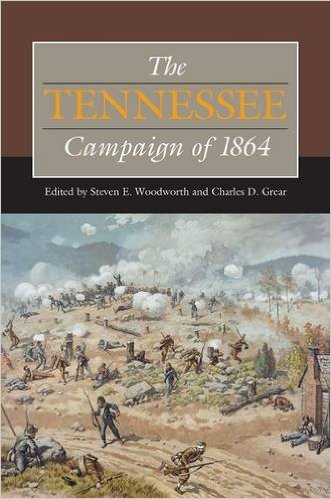The Tennessee Campaign of 1864 edited by Steven E. Woodworth and Charles D. Grear. Southern Illinois University Press, 2016. Cloth, ISBN: 978-0-8093-3452-0. $34.50.
 John Bell Hood’s invasion of Tennessee in the autumn of 1864 continues to fascinate students of the Civil War. In the dying days of the Confederacy, the ill-fated Army of Tennessee embarked on a great forlorn hope to destroy a numerically superior foe, capture a heavily fortified city, and turn the war around. The actual result: a pyrrhic victory at Franklin followed by a catastrophic defeat at Nashville. These two battles, among other related topics, are the focus of The Tennessee Campaign of 1864. Edited by Steven Woodworth and Charles Grear, this book is a collection of thirteen original essays by leading scholars in the field. While not a comprehensive study, it reinterprets familiar facets of the campaign while presenting welcome insights into overlooked ones.
John Bell Hood’s invasion of Tennessee in the autumn of 1864 continues to fascinate students of the Civil War. In the dying days of the Confederacy, the ill-fated Army of Tennessee embarked on a great forlorn hope to destroy a numerically superior foe, capture a heavily fortified city, and turn the war around. The actual result: a pyrrhic victory at Franklin followed by a catastrophic defeat at Nashville. These two battles, among other related topics, are the focus of The Tennessee Campaign of 1864. Edited by Steven Woodworth and Charles Grear, this book is a collection of thirteen original essays by leading scholars in the field. While not a comprehensive study, it reinterprets familiar facets of the campaign while presenting welcome insights into overlooked ones.
The first two essays examine aspects of Hood’s preliminary maneuvering in northern Georgia prior to the actual invasion. William Lee White proffers his annotated version of a forgotten portion of Patrick Cleburne’s diary covering the weeks of September and October. The entries give few insights into the rebel general’s renowned leadership, but on occasion they reveal a bit of the man’s personality. Cleburne griped about bedbugs, cringed when he watched a soldier boil alive a crawfish, and waxed poetic about Georgia’s autumnal landscape. Stewart Bennett’s piece is a fast-paced narrative of the Battle of Allatoona Pass (October 5), a ferocious yet largely ignored engagement. The author states that Union victory in this battle contributed to Hood’s decision to dispense with regaining Atlanta and instead head north.
John Lundberg steers to reader into the campaign proper with a fine synopsis of the oft-debated rebel blunders at Spring Hill on the night of November 29. The author puts this incident in its proper place. Confederate generals—especially Hood himself—indeed made many mistakes in carrying out their attack, but the persistent assertion that they could have destroyed an entire Union corps is Lost Cause fantasy.
The carnage at Franklin and the fighting around Nashville are the subject of two essays each. In a vivid description of Hood’s failed assault at Franklin, Andrew Bledsoe poignantly claims that the slaughter of so many veteran Confederate field officers, including Patrick Cleburne, not only wrecked the combat power of the Army of Tennessee, but essentially marked the military moment of death for the Confederacy as a whole. Jonathan Steplyk’s offering scrutinizes the close order fighting that made Franklin such a bloodbath. Applying the model of “killology” put forth by modern army psychologist Dave Grossman, Steplyk explains how combat mania gripped contestants on both sides, producing a frightening willingness to kill for a sustained period on scale rarely seen even in a conflict as sanguinary as the Civil War. D. L. Turner and Scott Stabler co-author a piece on the activities of black regiments during a diversionary attack on the Confederate right at Nashville, while Woodworth showcases the decisive role played by men under Gen. A. J. Smith in breaking the Confederate left outside the capital city. The former highlights the undeniable combat mettle of African-Americans; the latter affirms that well-led and highly motivated veteran troops are always a sight to behold once committed to action.
The book’s two most argumentative essays address the command relationship between union generals Ulysses Grant and George Thomas. Brooks D. Simpson defends Grant from the enduring notion that the commanding general needlessly interfered with Thomas’s plans to repel the Army of Tennessee. The friction between the two men stemmed less from personal animosity and more from miscommunication, where the limitations of telegraphy resulted in a frustrating effort to share timely information. Simpson does temper the critique of Grant’s impatience, but he does not wholly absolve the general of his irrational faithlessness in Thomas; the period between Grant’s first, frantic demand for action and Thomas’s devastating counter-offensive was barely a fortnight. Paul Schmelzer’s essay calls into question the high regard most historians have of Thomas’s leadership. Shrewdly analyzing the general through the lens of Clausewitzian military theory, Schmelzer contends that Thomas never appreciated the political dimension of Hood’s invasion. The impressive triumph at Nashville affirms the general’s gift for tactics, but his typically methodical preparations were conducted in a vacuum that ignored the strategic context. Conversely, Grant fully understood the political situation— hence his insistence that Thomas assume the offensive with ultimate victory so near. Both authors make provocative points, though it is puzzling that neither draws on Brian Steel Wills’s definitive biography of George Thomas.
The last four essays explore the realms of battlefield observation, perception, and legacy. John Gaines studies the civilians caught up in the movement of armies. Hundreds of non-combatants not only witnessed the fighting, but actually participated in the campaign. Local Tennesseans freely fraternized with both sides: distributing food, providing medical assistance, and catching up with loved ones—or, in some cases, even falling in love. Charles Grear shifts the focus to Texas. Paradoxically, as that state became more isolated from the Confederacy, its residents and soldiers grew more vested in the war’s outcome. The shocking finality of the defeats around Nashville thus became a topic that proud Texans loathed to mention. Timothy Smith and Jennifer Murray chronicle, respectively, battlefield preservation efforts at Franklin and Nashville. Unlike the war’s more famous hallowed grounds, such as Gettysburg, efforts to protect these two sites have always been sporadic. Both authors note that overcoming this unfortunate level of neglect involves a new kind of warfare against present-day ignorance and indifference.
There is much to like in this book. All thirteen essays are informative, deeply researched, and well written. Together, they cover virtually every perspective: Union and Confederate, white and black, soldier and civilian, heritage and legacy. In sum, The Tennessee Campaign of 1864 is an excellent addition to Civil War historiography.
Ben H. Severance is Professor of History at Auburn University Montgomery. He is the author of Portraits of Conflict: A Photographic History of Alabama in the Civil War (2012).
